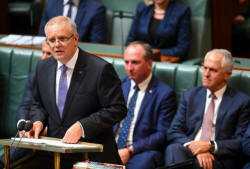|
Australia forecasts A$7.4
billion surplus in 2020/21, hits multinationals and
banks with higher taxes
 Send a link to a friend
Send a link to a friend
 [May 09, 2017]
By Swati Pandey and Jane Wardell [May 09, 2017]
By Swati Pandey and Jane Wardell
CANBERRA
- Australia's conservative government pledged to deliver a small budget
surplus in four years to end more than a decade of deficits that have
threatened its prized triple-A credit rating, but blew out the 2017/18
shortfall by abandoning so-called "zombie savings" that have been
blocked by a hostile Senate.
Flagging in the polls, the Liberal Party-led coalition government used
its annual budget on Tuesday to fast track major rail and road projects,
deliver some sweeteners for home buyers in an overheated property market
and impose tax hikes on foreign multinationals and the country’s
profitable major banks.
Treasurer Scott Morrison promised to deliver a small A$7.4 billion ($5.4
billion) surplus in 2020/21, an improvement on the A$1.08 billion it
forecast in the mid-year review in December.
However, he projected a bigger A$29.4 billion shortfall for 2017/18 than
the A$28.7 billion forecast at the mid-year review in December as it
dropped savings measures, including welfare payment reforms, that had
been artificially propping up the finances after opposition parties in
the upper house of parliament refused to pass them into law.
"We have listened carefully to the issues the ratings agencies have
raised," Morrison told reporters in a briefing ahead of the public
release of the budget late on Tuesday, referring to warnings from
Standard & Poor’s, Fitch and Moody’s that an inability to balance its
finances risked Australia's place among just a dozen countries with the
top rating from all three agencies.

"We must live within our means and this is an honest budget," Morrison
said. "I think it will be well received, but it’s ultimately up to
agencies to make their own decisions."
Australia’s A$1.7 trillion economy has outperformed many of its rich
world peers since the global financial crisis, but it has in more recent
years struggled to manage the end of a mining investment boom that
underpinned much of its wealth.
Among revenue boosting measures was a six-basis point levy on the
liabilities of banks with liabilities of more than A$100 billion from
July 1, a move that will help the government raise A$6.2 billion through
2020/21 to aid budget repair.
“The only people paying more tax on July 1 are large banks and
multinationals,” Morrison said, adding that the government expected to
raise A$4 billion this financial year in multinational tax from large
public companies and corporates.
[to top of second column] |

Australia's Treasurer Scott Morrison delivers the federal budget in
the House of Representatives at Parliament House in Canberra,
Australia, May 9, 2017. AAP/Lukas Coch/via REUTERS

HOUSING AFFORDABILITY
With the latest Newspoll showing the government trailing the opposition Labor
Party at 52 points to 48 points, the budget contained measures to appease an
electorate angry that a surging property market means they are unlikely to
achieve the great Australian dream of owning their home.
Morrison said the government will establish a A$1 billion National Housing
Infrastructure Facility and allow first time home buyers to save extra funds
into their pension fund accounts, to be taxed at a more favorable rate, to use
for a purchase deposit.
The Reserve Bank of Australia (RBA) last week held interest rates at a record
low 1.50 percent, citing concern about fuelling more borrowing in the red-hot
property market, particularly in Sydney and Melbourne.
In
another measure likely to appeal to the public after a series of scandals,
Morrison increased the potential fines for banks that breach misconduct rules
and tougher penalties for bank executives who fall foul of the rules.
Another A$1.2 billion will be raised over the next four years by imposing a levy
on foreign workers, another issue that has been heavily debated publicly, with
Prime Minister Malcolm Turnbull promising earlier this year "Australian jobs for
Australians."
The budget forecast real GDP at 2.75 percent in 2017/18, strengthening to 3
percent through to 2020/21. That compares with the RBA’s estimates of 2.75-3.75
percent by mid-2018 through to June 2019.
It sees the unemployment rate at 5.75 percent in 2017/18, easing from a 13-month
high of 5.9 percent currently while it pegged the consumer price index (CPI) at
2 percent, climbing to 2.5 percent by 2020/21. Underlying inflation is stuck
below the RBA’s target band of 2-3 percent with wages crawling at their slowest
pace on record.
Morrison outlined plans to deliver A$75 billion in infrastructure funding and
financing over the next years as the base of Australia’s next growth wave.
Projects include a A$10 billion national rail program, A$8.4 billion in funding
for a Melbourne to Brisbane inland railway, a A$5.3 billion injection into a
second airport in Sydney and an extension of the Snowy Hydro scheme.
[© 2017 Thomson Reuters. All rights
reserved.] Copyright 2017 Reuters. All rights reserved. This material may not be published,
broadcast, rewritten or redistributed. |